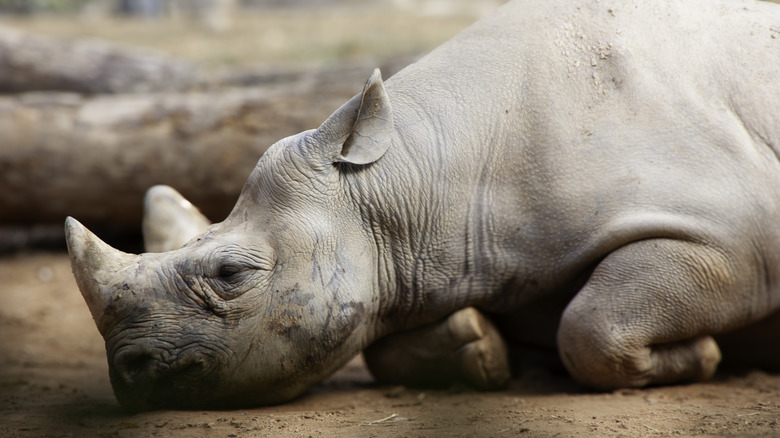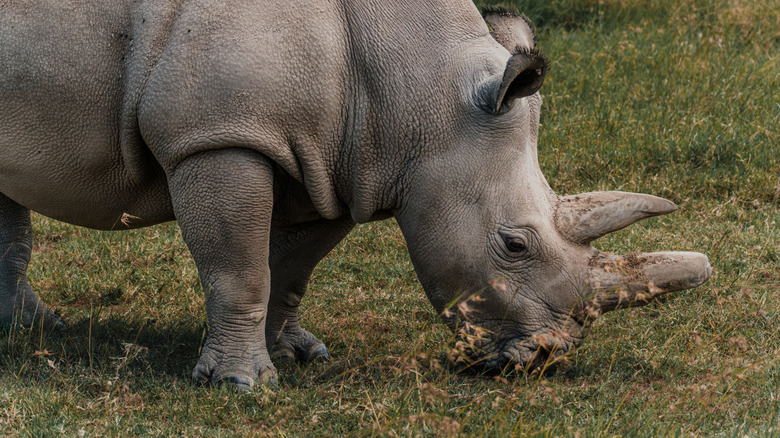No, Northern White Rhinos Aren't Extinct Yet, But They Might As Well Be
As sad as it is to acknowledge, there are more than a million animal species on the brink of extinction today, and things are only going to get worse. That means that even with intense efforts to save these animals, we'll be losing entire species forever in the coming years.
Some of the more severely endangered species of animals are the African forest elephant, North Atlantic right whale, and the northern white rhino, the latter of which is right on the cusp of disappearing forever. There are only two northern white rhinos alive today, both of which are female. That would make natural reproduction impossible, but the situation is even more dire as both surviving northern white rhinos are incapable of carrying pregnancies, making the species functionally extinct.
In the face of what seems like overwhelming odds, scientists are still trying everything they can to keep the northern white rhino alive. The methods being employed, however, are controversial, and the fate of the species very much hangs in the balance.
Rhinos have been hunted for centuries, with dire results
Rhinos have faced a major threat from poachers for centuries, and that threat remains today. According to Save the Rhino, in the last decade alone, 9,396 rhinos have been slaughtered for their horns in Africa, with one rhino being killed by poachers every 16 hours.
Like horse hooves, turtle beaks, and even our own hair and fingernails, rhino horns are made of keratin, which remains sought after due in part to its supposed medicinal qualities, none of which are based in scientific fact. Rhino numbers were also dramatically reduced by European trophy hunters in the colonial era, a practice which sadly persists through the Africa–Asia black market, where wealthy buyers in the East pay good money for rhino horn which they then gift to others or keep as a status symbol of sorts. There's also a big market for rhino horn carvings, necklaces, and other jewelry.
There has been so much damage caused by these practices, and the northern white rhino is one of the most impacted victims. The subspecies of the white rhino was once prevalent across Central Africa, with half a million in existence at the beginning of the 19th century. By the 1970s, that number had fallen to just 70,000 before dropping to a few hundred by the end of that decade. Today, the northern white rhino is functionally extinct, meaning the species is no longer viable and there are no individuals left to reproduce.
The last remaining northern white rhinos
The only two northern white rhinos in existence today are two females named Najin and Fatu. Together they represent the only hope of preserving the species, but with no males left in existence and some questionable preservation methods being explored, it looks as though the northern white rhino will soon belong to history.
Najin and her daughter, Fatu, now live on the wildlife reserve known as Ol Pejeta in northern Kenya, but it has been a long journey to their current situation. Back in the mid-70s, Czech zoo director Josef Vágner and his team traveled to South Sudan and rounded up six northern white rhinos, bringing them back to Europe in an attempt to encourage mating among the endangered species. However, mating efforts proved difficult until a female rhino from the London Zoo was transported to what was then Czechoslovakia. This female's third calf was Najin, who was born in 1989. After this, prompting breeding among the remaining northern white rhino became challenging once again, though Najin was ultimately able to mate with a bull from San Diego. This resulted in the birth of Fatu in 2000.
In 2009, Fatu and her mother were moved to the Ol Pejeta Conservancy, along with a male named Sudan who was Najin's father, and Fatu and Najin's half-brother, Suni. Mating continued to prove difficult, however, and after Suni died, that left just three northern white rhinos alive, and just one male: Sudan. Sadly, Sudan died in 2018, leaving behind Najin and Fatu, who were both evaluated by a specialist who determined that neither could carry a pregnancy. At this point, with no hope of reproducing, the species became functionally extinct. Today, two armed guards are always present to prevent Najin and Fatu from the still-prevalent threat of poachers.
Scientists are still trying to save the northern white rhino
It's a strange time to be alive when many scientists claim that extinction doesn't have to be the end of a particular species. But that's exactly where we are. Through gene editing and in vitro fertilization, scientists intend to preserve the northern white rhino species and restore the population in Africa. The process involves using embryos from Fatu, which have been edited in a lab, and implanting them into surrogates from the southern white rhino species, which is closely related to the northern white rhino.
Southern white rhinos diverged from their northern counterparts around 200,000 years ago. While at first glance the two species are almost indistinguishable, the northern white rhinos are typically larger, with bigger skulls and feet, and hair on their ears. Like the northern species, however, southern white rhinos have been hunted for centuries, and there are currently just 10,000 in existence. Still, that's more than enough for scientists to be able to start restoring the northern white rhino. Doing so, however, is more controversial than you might think.
A partner in the rhino project is Colossal Biosciences, the same company involved in the project to bring the Tasmanian Tiger back from extinction and the contentious "resurrection" of the dire wolf, which some argue constituted the creation of designer gray wolves and not true dire wolves. With northern white rhinos, Colossal Biosciences aims to turn the rhinos' pluripotent stem cells into reproductive cells and splice them with DNA from preserved skulls of northern white rhinos. Whether the process will prove successful or the results will even truly constitute the revival of the northern white rhino, however, is still a hotly debated topic.



